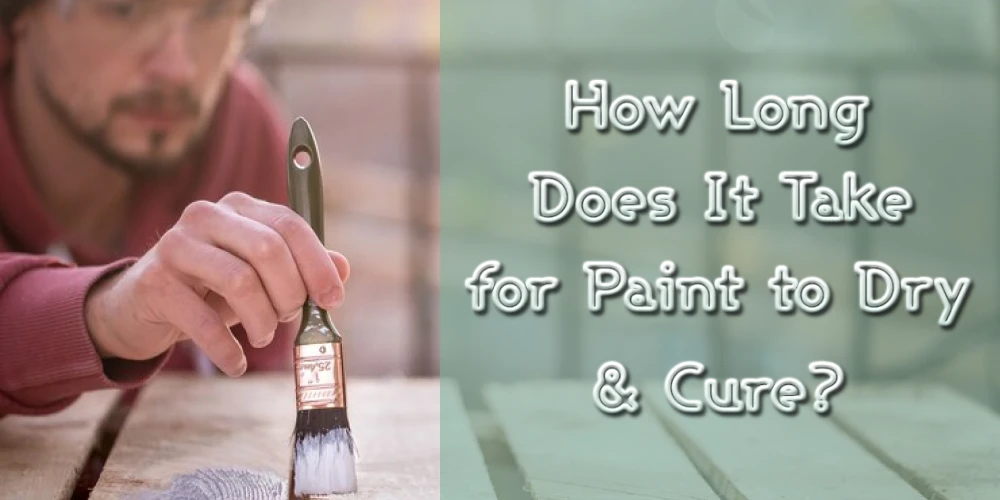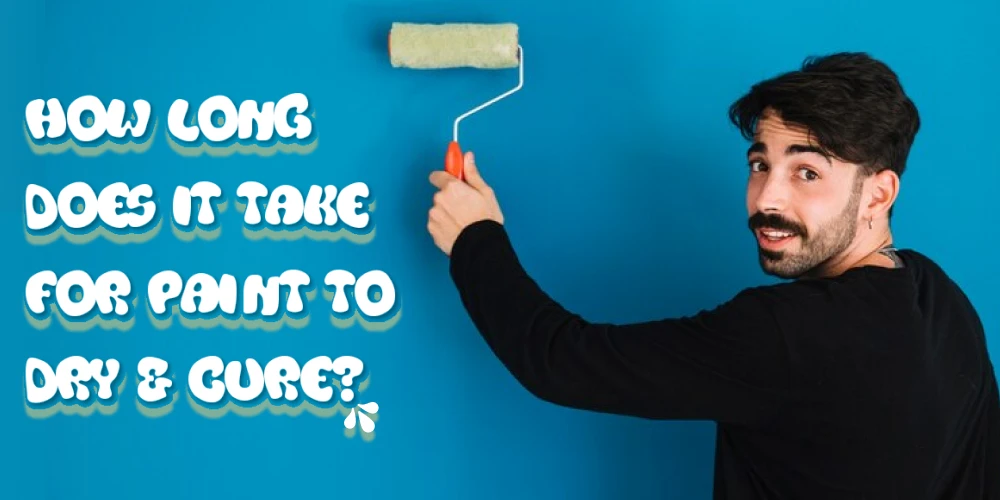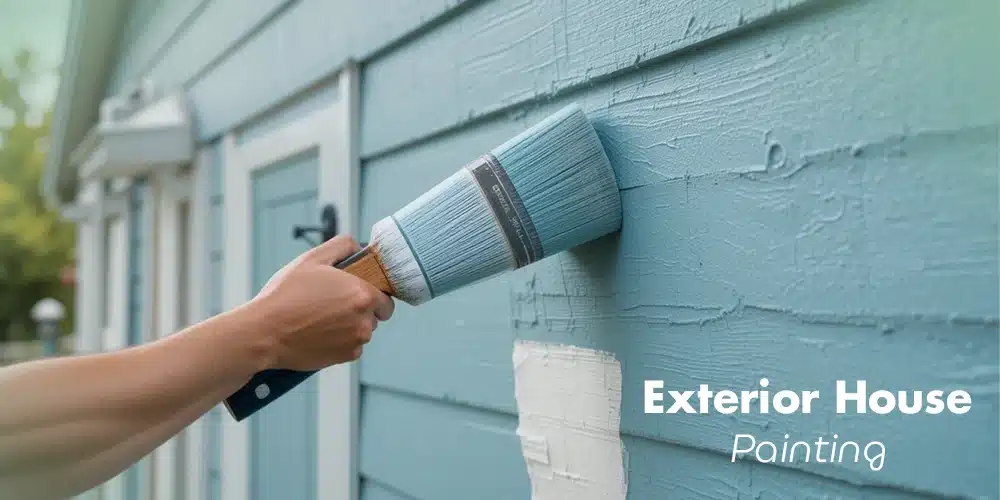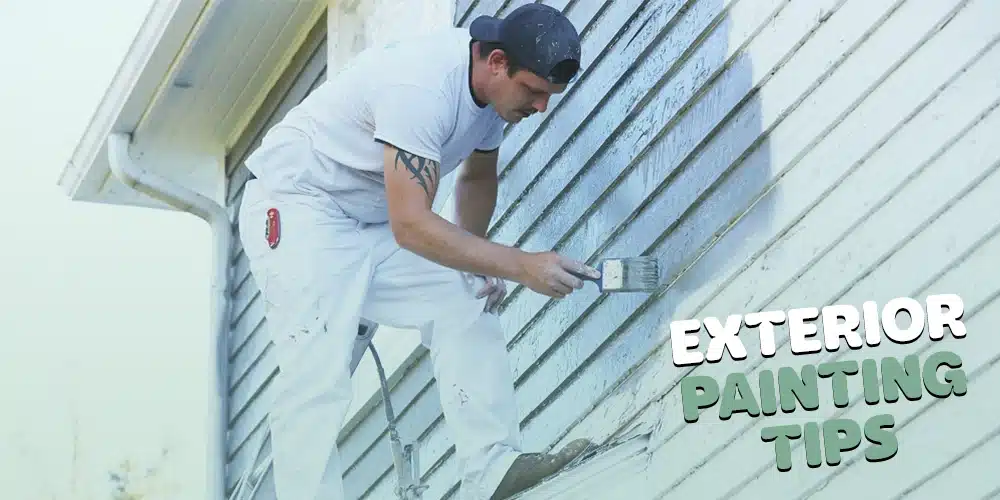When you take on a painting project, the excitement of transforming a room is undeniable. But let’s be real for a second — once you’ve got that fresh coat of paint on the walls, the most common question that pops up is: How long do I have to wait before I can touch it, or worse, ruin it? It’s that critical moment when you’re pacing around, waiting to get things back in order. Well, don’t fret! Whether you’re a DIY enthusiast or a professional painter, understanding the differences between paint drying and curing, along with how long it takes for paint to do its magic, is essential for achieving a lasting and flawless result.
So, let’s learn about paint drying and curing, and help you master the timeline of your next painting project. Buckle up — because you’re about to learn everything you need to know!
What is the Difference Between Paint Drying and Curing?
Before diving into the specifics, let’s clarify the difference between drying and curing because they are often used interchangeably but mean different things.
Drying refers to the process where the paint’s solvent (usually water or oil) evaporates, causing the paint to become dry to the touch. The paint may appear dry within hours, but that doesn’t mean it’s ready for the next coat or for any wear and tear.
Curing, on the other hand, is the chemical process that occurs after drying, where the paint hardens and bonds to the surface. Curing typically takes much longer than drying and involves the paint molecules cross-linking to form a durable, resilient coating. It ensures that the paint can withstand regular wear and tear, such as scrubbing or minor bumps.
How Long Does It Take for Paint to Dry?
The drying time for paint can vary based on the type of paint, the conditions of the room, and the surface being painted. Below, we will break down the approximate drying times for different kinds of paint.
Paint Type | Drying Time (to the Touch) | Curing Time |
Latex Paint | 1-2 hours | 2-4 weeks |
Oil-Based Paint | 6-8 hours | 30 days |
Spray Paint | 15-30 minutes | 5-7 days |
1. Latex Paint
Latex or water-based paint is one of the most commonly used types of paint due to its ease of use, fast drying time, and versatility. On average, latex paint takes about 1 to 2 hours to dry to the touch. However, it’s essential to wait at least 4 hours before applying a second coat to avoid streaking or uneven coverage.
Key Factors Affecting Drying Time:
- Humidity and Temperature: High humidity or low temperatures can significantly slow down the drying process. Ideal conditions for latex paint are temperatures between 50°F and 85°F with low humidity.
- Type of Surface: Porous surfaces such as drywall or wood will absorb more moisture, which may extend drying times.
2. Oil-Based Paint
Oil-based paints take longer to dry compared to latex paints. On average, it takes 6 to 8 hours for oil-based paints to dry to the touch. However, you should wait 24 hours before applying a second coat. Oil-based paints also require a longer curing time.
Key Factors Affecting Drying Time:
- Ventilation: Oil-based paints release strong fumes, so adequate ventilation is essential for proper drying.
- Surface Type: Similar to latex paint, surfaces like wood may absorb more moisture and affect drying time.
3. Spray Paint
Spray paint dries the fastest of all types, with most spray paints drying to the touch in about 15 to 30 minutes. However, for best results, allow 1 hour before handling or applying a second coat. Spray paint curing can take up to 24 hours.
Key Factors Affecting Drying Time:
- Humidity: If you’re spraying paint in a humid area, it may take longer to dry.
- Surface Texture: Smooth surfaces allow faster drying as the paint can settle quickly, while textured surfaces may take longer to dry.
How Long Does It Take for Paint to Cure?
While the paint may feel dry, it is not truly functional until it has fully cured. Curing is what makes the paint durable and ready for everyday use. Most paints cure within 7 to 30 days, depending on the type and conditions.
1. Latex Paint Curing Time
Latex paint takes about 2 to 4 weeks to fully cure. Though the paint will appear dry to the touch within a few hours, it’s important to avoid touching, cleaning, or hanging pictures on walls during the curing process. This allows the paint to form a tough and durable finish.
2. Oil-Based Paint Curing Time
Oil-based paints typically take 30 days to cure fully. This is a longer process because the paint’s solvent-based properties make it slower to harden. Even though oil-based paint is dry to the touch after about 6 hours, you should avoid scrubbing or handling it too roughly for a month to ensure durability.
3. Spray Paint Curing Time
Spray paint has a slightly faster curing time than oil-based paints. It typically cures within 5 to 7 days. Be cautious not to expose spray-painted surfaces to moisture or heavy use during this period.
Factors That Affect Paint Drying and Curing Time
Several environmental and situational factors can affect how long it takes for your paint to dry and cure. Here are some of the most critical ones:
Factor | Effect on Drying and Curing |
Temperature | Higher temperatures speed up drying and curing. |
Humidity | High humidity slows down drying and curing. |
Air Circulation | Good ventilation speeds up drying. |
Surface Type | Porous surfaces like wood absorb moisture, slowing drying. |
Paint Thickness | Thicker coats take longer to dry and cure. |
1. Temperature
Higher temperatures speed up the evaporation of the solvents in the paint, causing it to dry more quickly. However, excessive heat can also cause the paint to dry too quickly, resulting in uneven coverage or brush marks. The optimal temperature for painting is between 50°F and 85°F.
2. Humidity
Humidity can extend both drying and curing times. High humidity levels in the air make it difficult for the solvents in the paint to evaporate, resulting in slower drying times. Ideally, aim for low humidity when painting for faster results.
3. Air Circulation
Good ventilation helps paint dry faster by facilitating solvent evaporation. In rooms with poor air circulation, you may notice that paint takes longer to dry. Use fans or open windows to improve airflow if needed.
4. Surface Type
The surface you’re painting on affects the drying time. Absorbent surfaces like wood or drywall may take longer to dry than non-porous surfaces such as metal or plastic. Before painting, ensure that the surface is clean and dry for optimal results.
5. Paint Thickness
Applying multiple thick coats of paint can extend both drying and curing times. If you’re using multiple coats, allow adequate drying time between each layer to ensure the paint cures properly.
How to Speed Up the Drying and Curing Process
While patience is key, sometimes you need to speed up the process. Here are some practical tips to help you do just that:
- Increase Ventilation: Open windows and use fans to circulate air and help the paint dry faster.
- Adjust Temperature: Use a heater to raise the room temperature, or employ air conditioning in hot, humid conditions.
- Use a Faster-Drying Paint: If time is of the essence, consider using paint formulated for faster drying and curing.
- Use a Thin Coat: Apply multiple thin coats instead of one thick coat. Thin coats dry and cure faster.
- Use Fast-Drying Additives: Some paints come with additives that speed up the drying process, so check if your paint can be enhanced this way.
How to Test If Your Paint is Fully Cured - A Quick Guide
After waiting for what feels like an eternity, it’s easy to assume that your freshly painted walls are ready for action once the paint feels dry to the touch. However, there’s a crucial distinction between paint being dry and fully cured. So, how do you make sure your paint job has reached its ultimate, durable form? Simple — by testing the surface to check if it’s truly cured.
Here’s the thing: while paint may appear dry and even look perfect on the surface, it could still be in the process of curing — meaning it might not be as durable as you expect. Whether it’s a kitchen with high traffic, a bathroom that will see moisture, or a freshly painted doorframe, it’s vital to ensure that the paint is fully cured before putting it to the test in everyday conditions. So, how can you determine whether or not it’s fully ready?
The Fingernail Test
One of the simplest and most effective ways to test if your paint has cured is to use your fingernail. Here’s how to do it:
- Choose a small, discreet area of the painted surface where you won’t mind doing the test. A corner of the wall, the baseboard, or an edge of the doorframe is a good spot.
- Gently press your fingernail into the paint and hold it there for a few seconds.
- Assess the results:
- If your fingernail leaves a visible indent or you feel the paint is still soft or pliable, it means the paint isn’t fully cured. The surface is still vulnerable and susceptible to damage.
- If the paint remains hard and smooth, with no visible indent or damage, then it has fully cured and is ready to handle regular wear and tear.
This test works because when paint cures, it undergoes a chemical process that transforms it from a soft, flexible coating into a hard, durable finish. It is this transformation that helps it withstand scuffs, scratches, and impacts, which is why it’s essential to wait until the curing process is complete.
The Knife Test (for Harder Paints)
For tougher or more resilient paint types, such as oil-based paints or high-gloss finishes, a knife test may be a more appropriate method to check curing. Here’s how you can do it:
- Use a small utility knife or a similar flat-edged tool. It’s essential that you choose something that won’t damage the surface unintentionally, so make sure it’s a blade you can control carefully.
- Gently press the edge of the blade into a hidden area of the painted surface.
- Evaluate the result:
- If the blade creates a visible mark or indentation, then the paint hasn’t fully cured.
- If the paint remains undisturbed, with no visible marks or scratches, it indicates that the paint is fully cured and ready for regular handling.
The knife test works well for tougher, high-performance paints because the blade puts more pressure on the surface, helping you determine if the finish is strong enough to resist wear and tear.
By the way, if you’re planning a big painting project and are wondering about other tips related to professional painters, you might be curious about tipping. Learn more about Do You Tip Painters? to get the best insight into painting etiquette!
Common Mistakes to Avoid When Painting
Even with the best drying and curing conditions, there are common mistakes that can impact the final result. Here are some pitfalls to watch out for:
- Applying a Second Coat Too Soon: As tempting as it may be, don’t rush into applying a second coat before the first coat is dry. This can lead to streaking, uneven coverage, or even peeling.
- Ignoring Drying and Curing Times: Many people think that once the paint feels dry, it’s ready for handling. Make sure to wait the full curing time to avoid damaging the paint job.
- Using Paint in Poor Conditions: Avoid painting in areas with excessive moisture, extreme temperatures, or inadequate ventilation. These factors can lead to uneven drying or curing issues.
Get the Perfect Finish with Expert Help
Understanding the drying and curing processes of paint is essential to achieving a perfect finish on any painting project. Whether you’re working with latex, oil-based, or spray paints, knowing the right times to wait before handling your paint can ensure that your work is both aesthetically pleasing and durable. Keep in mind that environmental conditions like temperature, humidity, and airflow can affect the drying and curing times, and proper patience is key.
If you’re planning to paint your home or office and want to ensure a flawless, long-lasting result, consider hiring a professional. Aaron’s Painting and Remodeling offers expert painting solutions, guaranteeing the perfect finish every time. Let our team handle the details while you sit back and enjoy a beautiful, fresh coat of paint. Contact us today for expert Professional Painting Services in Overland Park.
Contact APRC Painting Services Today!




